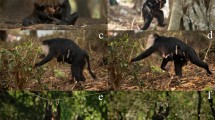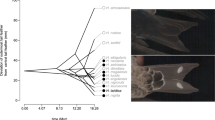Summary
Arabian babblers, Turdoides sqamiceps, are cooperatively breeding, group territorial birds, occurring in desert habitats. Non-breeders participate in several types of cooperative behaviour, including care of eggs, nestlings and fledglings, and bringing food to one another (allofeeding). This paper reports on observations of helping with eggs and young, and peer allofeeding, performed by immature babblers, fledged the previous season or earlier in the same season. The birds were from a babbler population studied since 1971 in the Arava valley of eastern Israel. They belonged to groups in which all individuals had been colourringed and were accustomed to human observers. Individuals and nests in the territories of these groups could be watched from distances of 1–2 m without causing alarm, so fine details of behaviour could be observed in the field. In most allofeeding interactions observed, a more dominant individual brought food to a subordinate. Sometimes the subordinate bird avoided accepting the proferred food, and was then hit or chased by the bird that had attempted to feed it. Occasionally a subordinate bird attempted to feed a more dominant individual. Dominant birds always refused to take food offered by a subordinate, and hit or chased any subordinate attempting to feed them. Frequencies of visits to nests were correlated with helper rank for those visits where the incoming bird displaced a previous visiter from the nest. Frequences of visits to unattended nests, however, were not correlated with helper rank. Similarly, frequencies of feeding visits to fledglings were correlated with helper rank until incubation of the next brood began. After this, the correlation disappeared. Numerous instances of aborted nest visits were observed in which a helper, often carrying food, arrived at the nest-tree but left again without visiting the nest. In many other cases, a helper arrived at the nest-tree but delayed visiting the nest for several minutes. Aborted and delayed visits usually occurred when a more dominant bird was in the vicinity of the nest. This suggests interference between helpers. Direct interference between helpers visiting fledglings was occasionally observed. In such cases, a more dominant helper snatched food from a subordinate approaching fledglings, and then fed this food to the fledglings itself. Interference between helpers, and conflict between proferers and recipients of food during allofeeding, are not easily explained by kin selection or reciprocity. On the other hand, such behaviour is readily explained by a hypothesis which suggests that individuals may increase their social status in the group by performing cooperative behaviour. Babblers that establish status by demonstrating ability to bear the short-term costs of cooperative behaviour, rather than through direct aggression towards rivals, are likely to forge collaborative relationships with other group members. Since babblers must collaborate to establish and defend a territory, such relationships are essential to reproductive success.
Similar content being viewed by others
References
Brown JL (1974) Alternate routes to sociality in jays with a theory for the evolution of altruism and communal breeding. Am Zool 14:63–80
Brown JL (1975) Helpers among Arabian babblers, Turdoides squamiceps. Ibis 117:243–244
Brown JL (1978) Communal breeding in birds. Annu Rev Ecol Syst 9:123–155
Brown JL, Brown RH (1981) Kin selection and individual selection in babblers. In: Alexander RD, Tinkle DW (eds) Natural selection and social behavior. Blackwell, London, pp 244–256
Carlisle TR (1981) Altruism between in-laws: Some predictions from kin-selection theory. Behav Ecol Sociobiol 8:157–159
Emlen ST (1978) The evolution of cooperative breeding in birds. In Krebs J, Davies N (eds) Behavioural Ecology: An evolutionary approach. Blackwell Scientific Publications, London, England, pp 245–281
Emlen ST (1981) Altruism, kinship and reciprocity in the whitefronted bee-eater. In: Alexander RD, Tinkle DW (eds) Natural selection and social behavior. Blackwell, London, pp 217–230
Emlen ST (1982) The evolution of helping: I. An ecological constraints model. Am Nat 119:29–39
Fry CH (1972) The social organization of bee-eaters (Meropidae) and cooperative breeding in hot-climate birds. Ibis 114:1–14
Gaston AJ (1977) Social behaviour within groups of jungle babblers. Anim Behav 15:828–848
Hamilton WD (1964) The genetical evolution of social behaviour. I, II. J Theor Biol 7:1–52
Ligon DJ, Ligon SH (1978) Communal breeding in green wood-peckers as a case for reciprocity. Nature 276:496–498
MacRoberts MH, MacRoberts BR (1976) Social organization and behavior of the Acorn Woodpecker in central coastal California. Ornithol Monogr 21:1–115
Maynard Smith J, Ridpath MG (1972) Wife sharing in the Tasmanian native hen, Tribonyx mortierii: A case of kin selection? Am Nat 106:447–452
Skutch AF (1961) Helpers among birds. Condor 63:198–226
Sokal RR, Rolf FJ (1969) Biometry. W.H. Freeman, San Francisco
Stallcup JA, Woolfenden GE (1979) Family status and contributions to breeding by Florida Scrub Jays. Anim Behav 26:1144–1156
Trivers RL (1971) The evolution of reciprocal altruism. Q Rev Biol 46:35–57
West-Eberhard MJW (1975) The evolution of social behavior by kin selection. Q Rev Biol 50:1–33
Woolfenden GE (1975) Florida Scrub Jay helpers at the nest. Auk 92:1–15
Woolfenden EG, Fitzpatrick J (in press) The Florida Scrub Jay: Demograph of a cooperative breeding bird. Princeton University Press, Princeton, New Jersey
Zahavi A (1974) Communal nesting by the Arabian babbler: A case of individual selection. Ibis 116:84–87
Zahavi A (1975) Mate selection — a selection for a handicap. J Theor Biol 53:205–214
Zahavi A (1976) Cooperative nesting in Eurasian birds. Proc XVI Int Ornithol Congr (Canberra, Australia) pp 685–693
Zahavi A (1981) Natural selection, sexual selection and the selection of signals. In: Scudder GGE, Reveal JC (eds) Evolution today. Proc 2nd Int Congr Syst Ecol pp 133–138
Author information
Authors and Affiliations
Rights and permissions
About this article
Cite this article
Carlisle, T.R., Zahavi, A. Helping at the nest, allofeeding and social status in immature arabian babblers. Behav Ecol Sociobiol 18, 339–351 (1986). https://doi.org/10.1007/BF00299665
Received:
Accepted:
Published:
Issue Date:
DOI: https://doi.org/10.1007/BF00299665




